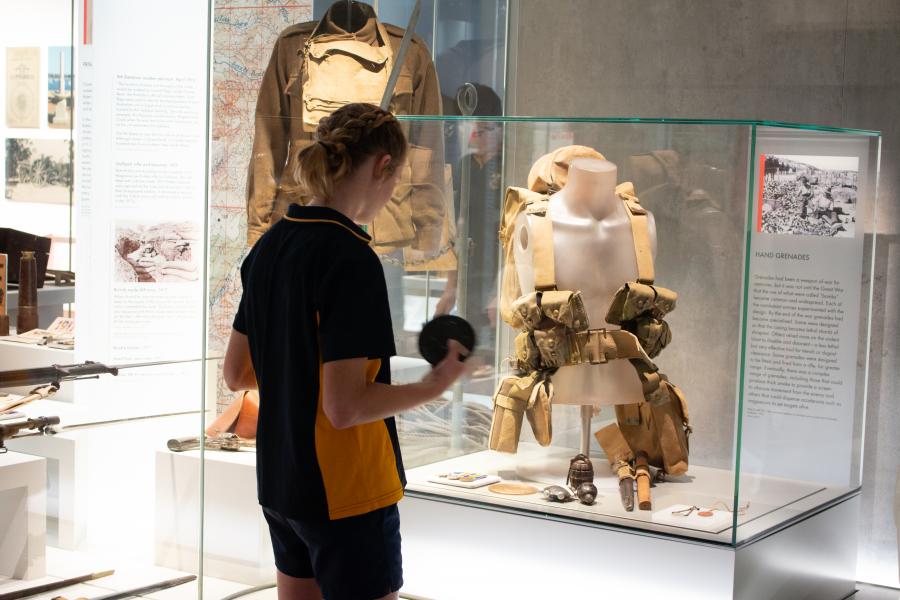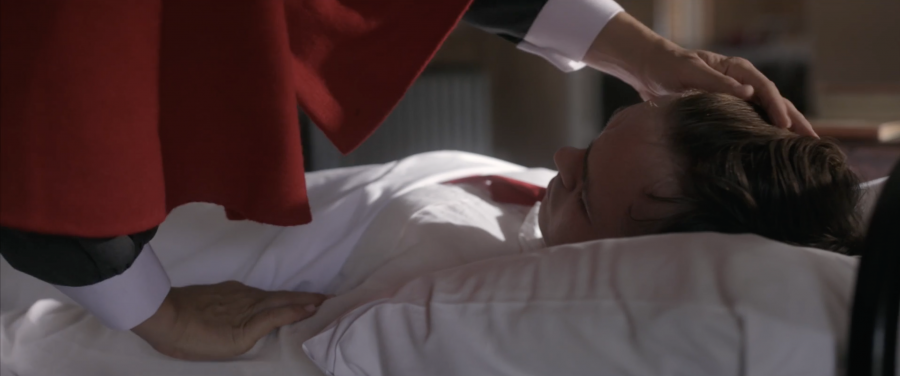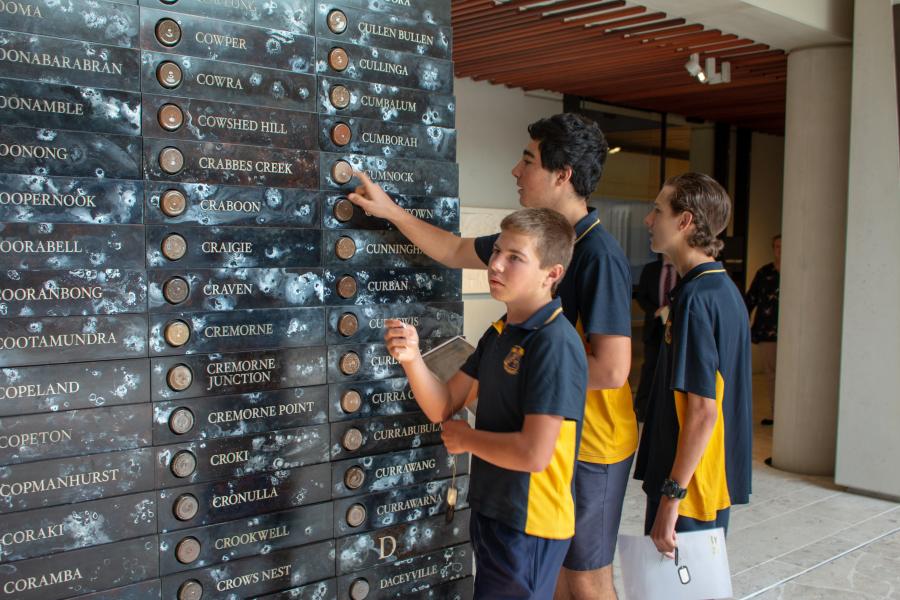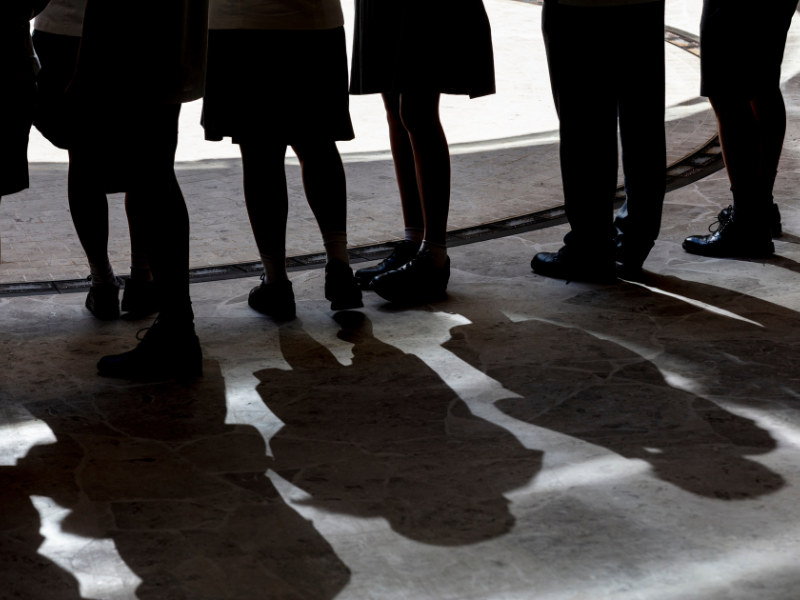STAGE 5: YEARS 9 & 10
20 Lives Through 20 Objects
Duration: 2 hours | Times: 9:30-11:30am; 12:00-2:00pm
Cost: $240 for up to 20 students / $480 for 20-40 students / $720 for 40-60 students
How do 20 seemingly innocuous objects reveal the intimate and personal experiences of our servicemen and women in the First World War? In this hands-on, practical workshop, students have the opportunity to learn more about the Great War through the lives of 20 extraordinary people whose stories are interwoven into the exhibition and content collection at the Anzac Memorial. Each student is invited to source evidence that not only reveals details about the journey of their given Anzac, but also what this meant more broadly for Australians at War – both on the front line and back home. The workshop culminates in a Star Ceremony, where people the students have researched are commemorated in a special service unique to the Anzac Memorial.
Curriculum links: Depth Study 3: Australians at War: World War I (1914–18) | Key inquiry question: What was the significance of World War I? How did new ideas and technological developments contribute to change in this period? Content: Overview of the causes of the war; the scope and nature of warfare; significant events and the experiences of Australians at war; impact of the wars on Australia; significance of the war to Australia; commemorations and the nature of the Anzac legend. | Outcomes: HT5–1, HT5–5, HT5–7, HT5–9, HT5–10
Devoted Service
Duration: 2 hours | Times: 9:30-11:30am; 12:00-2:00pm
Cost: $480 for up to 40 students / $720 for 40-60 students / $960 for 60-80 students / $1200 for 80-100 students / $1440 for 100-120 students
This moving and revealing workshop explores the vital role that the Medical Corps played throughout the First World War. During a powerful, live one-woman performance, the actions and values of three nurses and a matron are conveyed through firsthand written accounts. Students will learn about both the medical support provided, as well as the often overlooked emotional labour. Accessing original sources of poetry and reflections written by convalescent soldiers, students will explore the significance and purpose of correspondence, and will be encouraged to write their own letter from the perspective of someone serving during the war. The workshop concludes with a short film that brings to life an object on display in the exhibition that belonged to one of the NSW nurses who served during the Great War.
Curriculum links: Depth Study 3: Australians at War: World War I (1914–18) | Key inquiry question: What was the significance of World War I? How did new ideas and technological developments contribute to change in this period? | Content: Overview of the causes of the war; the scope and nature of warfare; significant events and the experiences of Australians at war, in particular the role of women; impact of the wars on Australia; significance of the war to Australia. | Outcomes: HT5–1, HT5–5, HT5–7, HT5–9, HT5–10
Anzac War Horses
Duration: 2 hours | Times: 9:30-11:30am; 12:00-2:00pm
Cost: $480 for up to 40 students / $720 for 40-60 students / $960 for 60-80 students / $1200 for 80-100 students / $1440 for 100-120 students
In this inspiring and moving seminar, we explore the role of the Australian Light Horse, to learn more about our First World War history through the unbreakable bond between man and horse. Discover our compelling Australian war horse story – the battles fought, won and lost that helped forge our national identity and give birth to a legend. The seminar includes a live theatrical performance of Loyal Creatures, written by Morris Gleitzman, a remarkable piece of historical fiction. Students also take part in a guided discovery tour of the Anzac Memorial and our new exhibition spaces. With knowledge gained from the tour, students then utilise perspective and fictional writing techniques to create their own short piece of historical fiction in response to the performance earlier in the workshop.
TESTIMONIAL "The mix between history and creativity made for a compelling performance piece which left a significant emotional impact on me."
Curriculum links: Depth Study 3: Australians at War: World War I (1914–18) | Key inquiry question: What was the significance of World War I? How did new ideas and technological developments contribute to change in this period? | Content: Overview of the causes of the war; the scope and nature of warfare; significant events and the experiences of Australians at war; impact of the wars on Australia; significance of the war to Australia; commemorations and the nature of the Anzac legend. | Outcomes: HT5–1, HT5–5, HT5–7, HT5–9, HT5–10
War at our Door
Duration: 2 hours | Times: 9:30-11:30am; 12:00-2:00pm
Cost: $240 for up to 20 students / $480 for 20-40 students / $720 for 40-60 students
The Second World War came perilously close to Australian shores in 1942. Darwin was bombed and midget Japanese submarines snuck into Sydney Harbour causing panic that Australia itself might be invaded while Australian soldiers were fighting overseas. Volunteers around the nation began to organise and train for the worst, goods were rationed and the news censored. This workshop brings to life the events surrounding the year of 1942 using the Anzac Memorial’s unique collection and Fiona Hall’s ‘100 significant sites’ artwork. Students will learn about Australia’s involvement in the Second World War and also how the scale, scope and nature of warfare changed during this period.
TESTIMONIAL"The Anzac Memorial was an eye-opener for me as I got to understand what the soldiers and families went through. It was heart-breaking to see and hear about the hardships they had to deal with".
Curriculum links: Depth Study 3: Australians at War: World War II (1939–45) | Key inquiry question: What was Australia's role in the Second World War? How were the lives of Australian citizens disrupted by the war? How did the nature of warfare change during this period? How did the Australian government try to manage the population during wartime? | Content: Overview of the causes of the war; the scope and nature of warfare; significant events and the experiences of Australians at war; impact of the wars on Australia; significance of the war to Australia. | Outcomes: HT5–1, HT5-4, HT5–5, HT5–7, HT5–9, HT5–10
Joint Excursions With The State Library of NSW
Make the most of your excursion with a joint visit to the Anzac Memorial and the State Library.
Your visit to the Anzac Memorial includes your choice between the Anzac War Horses or Devoted Service programs. Both workshops feature a moving piece of live theatre, a tour of the Anzac Memorial building, and an opportunity to discover the stories of Australians who served throughout the First World War in the Memorial’s Centenary Exhibition. At the State Library, your students will have the chance to handle, analyse and care for authentic artefacts and manuscripts from the First World War in the Hands On World War I workshop. Simply get in touch with either the Anzac Memorial or State Library teams, and we’ll organise both parts of your excursion for you.
This double program can accommodate a maximum of 120 students in one day. For more information about the State Library’s Hands On World War I program, please visit: https://www.sl.nsw.gov.au/learning/hands-world-war-i
STAGE 6: YEAR 11
The Anzac Memorial - The Past is Present
Duration: 2 hours | Times: 9:30-11:30am; 12:00-2:00pm
Cost: $240 for up to 20 students / $480 for 20-40 students / $720 for 40-60 students / $960 for 60-80 students / $1200 for 80-100 students
In this engaging workshop and exploratory tour, students discover how Australia's past has been represented and commemorated at the Anzac Memorial since its original opening in 1934. Accessing rare and original documentation, students trace the experience of servicemen and women who participated in the First World War to understand the significance and impact this had on Australia - particularly for women and families. As the principal Memorial in NSW, we also examine contemporary forms of memorialisation through the artwork and symbolism inherent in the Centenary Extension which opened to the public on 11 November 2018.
Curriculum links: Investigating Modern History - The Nature of Modern History Option 5: The Representation and Commemoration of the Past. The Shaping of the Modern World Topic 5: The First World War | Historical Concepts and Skills: Analysis and use of sources (ACHMH010, ACHMH008) Historical interpretation (ACHMH001, ACHMH011, ACHMH012), Historical investigation and research (ACHMH005), Explanation and communication (ACHMH013), The impact of war on civilians, including women's lives and the changing role of women (ACHMH064) | Content: How history is represented through the Anzac Memorial. The various ways the past is commemorated. The First World War and its role in shaping the modern world | Outcomes: MH11-2, MH11-4, MH11-5, MH11-6, MH11-7, MH11-8, MH11-10







